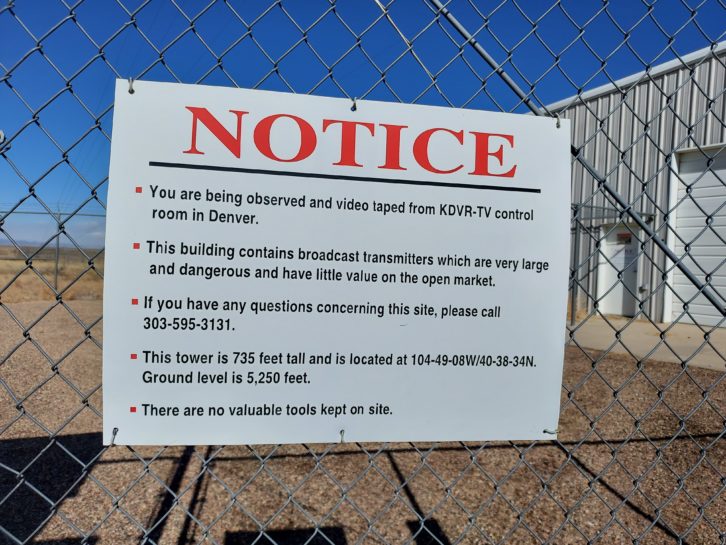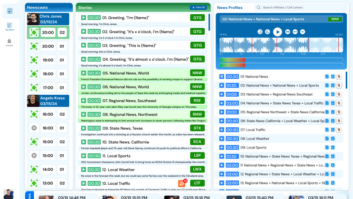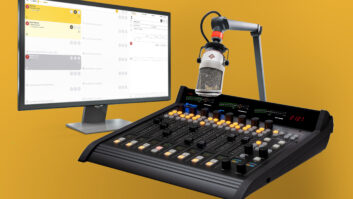If you’ve attended an SBE Ennes Workshop, you probably have met Fred Baumgartner, who unselfishly has devoted countless hours of time to the society.
Now retired, Fred recently visited a transmitter site that he built a million years ago (well, maybe 30), having not been there for decades.
Back then, Fred thought the sign shown here might be a good idea and would help prevent vandalism. As far as he knows, it has achieved that goal for all these years.

A 2022 version of the sign might drop the tower information, since you ID towers these days, as you know. The reference to videotape is dated, of course; and Fred wonders if anyone would answer a telephone these days.
Lots of big lights also illuminate the building at night — there’s nowhere to hide.
Fred hid the camera, an inexpensive model, in a PVC pipe that looked like a vent; it had a great view.
The return path was for ENG, so rather than send color bars back to the station, it was the camera feed. There were also cheap cameras in the building itself, so you could see smoke or an intruder. This was all before IP, of course.
The point of Fred’s sign was to make sure that folks with bad intentions were aware that someone … a real person … was keeping an eye on things and might hunt a would-be vandal down if they misbehaved.
Fred’s experience is that without a sign like this, a concrete block fortress can seem mysterious, depersonalized and isolated — a tempting target and possibly unmonitored.
Of course if someone really wanted to shoot out the tower lights or steal the copper, they could do it. But like your front-door lock, the sign is about keeping good people good.
Free meter
Portsmouth, R.I., engineer, Ihor Slabicky saw our mention in the May 11 column of the Darkwood website and their free volume indicator applications.
Ihor reminds us that engineers can visit the Orban website for a free meter as well. Click here to download your free Orban Loudness Meter.

(Quick quiz: What does URL stand for? Answer at the end.)
[Read Another Workbench by John Bisset]
Well, aren’t you a site …
Speaking of URLs, Paul Sagi writes from Malaysia with an interesting site.
PCrisk is a cyber-security portal, informing internet users about the latest digital threats. The content is provided by security experts and professional malware researchers.
For instance an interesting article on malware removal can be found here.
Meanwhile Dan Slentz has another site you’ll want to visit. Engineers are expected to fix everything, right? Well, this site offers free repair guides for “everything,” written by everyone!
You’ll find repair assistance for PCs, phones, electronic gear, household products, cameras, even medical products, with nearly 90,000 manuals. Sorry, no transmitters … yet!
The URL is simple: www.ifixit.com/.
Keepin’ it cool
Dan also read about a small 6,000 BTU mini-split air conditioning system by Oslo. He writes that small stations or low-budget operations can face cooling issues in makeshift studios. The issue is the sound generated by a typical wall-mount or window air conditioner. This model isolates the compressor and exchanger from the blower.
As you can see in the figure, the device straddles your windowsill. The cost is under $600.

One useful feature is resumption of operation if there is a power failure. The Oslo fits windowsills with up to an 11″ clearance.
For more information, search “Saddle Air Conditioners” here.
LISEN up
More and more phones and tables are finding their way into studios. Dan also found a useful cellphone/tablet stand for under $20 on Amazon. It accommodates thick cases, has a weighted base and is compatible with both mobile phones iPads or tablets.

Enter “LISEN cell phone stand” in the Amazon search block.
Quiz answer
URL stands for Uniform Resource Locator. As explained by the site developer.mozilla.org:
“A URL is nothing more than the address of a given unique resource on the Web. In theory, each valid URL points to a unique resource. Such resources can be an HTML page, a CSS document, an image, etc. In practice, there are some exceptions, the most common being a URL pointing to a resource that no longer exists or that has moved. As the resource represented by the URL and the URL itself are handled by the Web server, it is up to the owner of the web server to carefully manage that resource and its associated URL.”
Your tips help guide others on their journeys through radio. Email [email protected].












